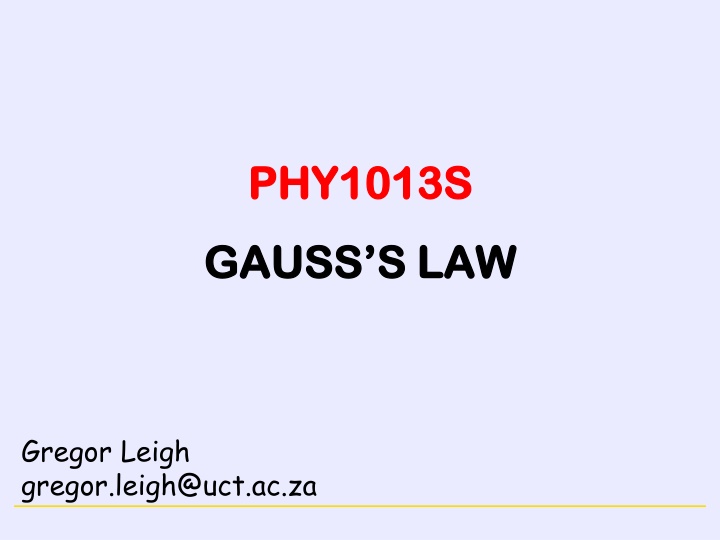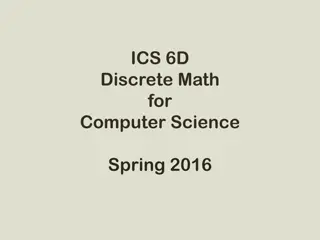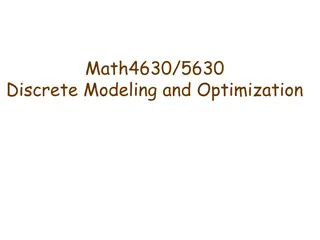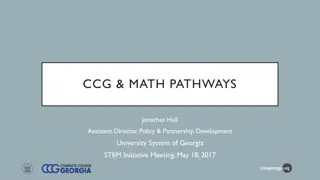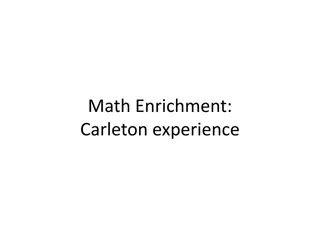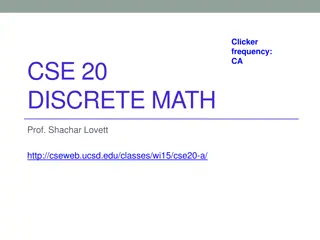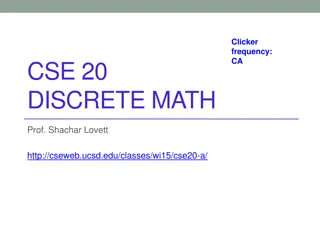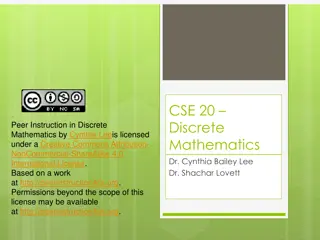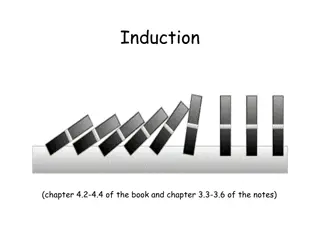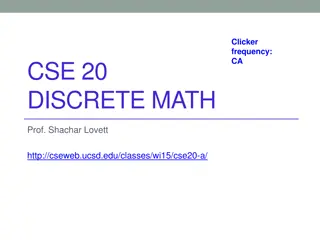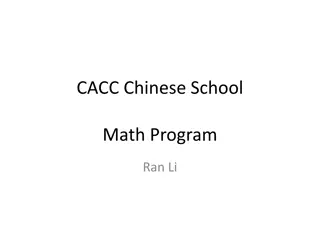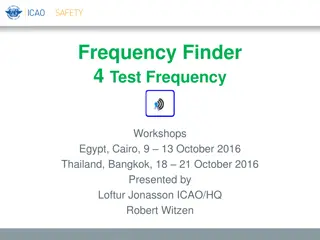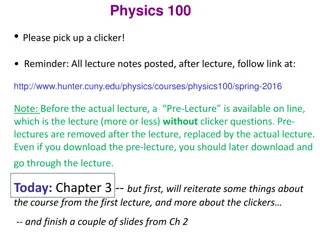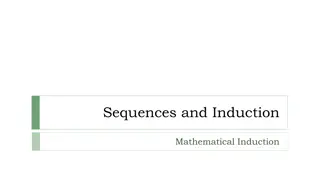Clicker Frequency in Discrete Math: Mathematical Induction
The concept of mathematical induction and its application in proving theorems using examples and a proof template. Delve into base and inductive steps for a comprehensive understanding.
Download Presentation

Please find below an Image/Link to download the presentation.
The content on the website is provided AS IS for your information and personal use only. It may not be sold, licensed, or shared on other websites without obtaining consent from the author.If you encounter any issues during the download, it is possible that the publisher has removed the file from their server.
You are allowed to download the files provided on this website for personal or commercial use, subject to the condition that they are used lawfully. All files are the property of their respective owners.
The content on the website is provided AS IS for your information and personal use only. It may not be sold, licensed, or shared on other websites without obtaining consent from the author.
E N D
Presentation Transcript
ELECTRICITY PHY1013S PHY1013S GAUSS S LAW GAUSS S LAW Gregor Leigh gregor.leigh@uct.ac.za
PHY1013S ELECTRICITY GAUSS S LAW GAUSS S LAW Learning outcomes: At the end of this chapter you should be able to Calculate the electric flux through a surface. Use Gauss s Law to calculate the electric field due to symmetric charge distributions. Use Gauss s Law to determine the charge distribution on hollow conductors in electric fields. 2
PHY1013S ELECTRICITY GAUSS S LAW FLUX n is the unit vector normalto a surface. An = = v E A is the surface s area vector. n A The amount of flow, , through the surface depends on: the magnitude of the velocity, v; the area of the surface, A; the angle between and . ( is a maximum when = 0 ; a minimum for = 90 .) v A = = v A Hence: = vAcos or just: Replacing the velocity vector with the electric field vector , we get: = = E A E e 3
PHY1013S ELECTRICITY GAUSS S LAW FLUX For a surface made up of small elements, each A, the total flux is = = E E A A For a closed (Gaussian) surface, in the limit A 0, [Nm2/C] = = E dA The electric flux through a Gaussian surface is proportional to the netnumber of electric field lines passing through that surface. 4
PHY1013S ELECTRICITY GAUSS S LAW Gaussian surface 3 1 2 5
PHY1013S ELECTRICITY GAUSS S LAW A = = E A E 1 1 Gaussian surface < 0 3 1 2 6
PHY1013S ELECTRICITY GAUSS S LAW Gaussian surface 3 1 2 E 2 2 A = = E A = 0 7
PHY1013S ELECTRICITY GAUSS S LAW A = = E A 3 E 3 > 0 Gaussian surface 3 1 2 8
PHY1013S ELECTRICITY GAUSS S LAW A cylindrical Gaussian surface of radius R is placed in a uniform electric field, with the cylinder axis parallel to the field. dA = 90 = 180 c E E b E dA a E = 0 dA What is the (net) flux of the field through this surface? = = E dA + + E dA + + E dA = = E dA b c a = = + + + + E dA E dA E dA (cos180 ) (cos90 ) (cos0 ) a b c = = + + + + E dA E dA E dA (0) a b c = = + + + + = = EA EA 0 0 9
PHY1013S ELECTRICITY GAUSS S LAW When will the net flux ever NOT be zero? 10
PHY1013S ELECTRICITY GAUSS S LAW GAUSS LAW The net electric flux through a Gaussian surface is proportional to the net charge enclosed: 0 = Qin Qin Substituting for , E dA = = Q 0 in Notes: Qin is the net, enclosedcharge. is the totalfield through the surface. E These equations are valid only in vacuum (or air). Gauss s Law is both easier to use and more universal/fundamental than Coulomb s Law. 11
PHY1013S ELECTRICITY GAUSS S LAW GAUSS S LAW: MULTIPLE CHARGES S3 S4 + S1 S2 12
PHY1013S ELECTRICITY GAUSS S LAW USING GAUSS S LAW TO DETERMINE ELECTRIC FIELDS 1. Draw the situation. 2. Choose a Gaussian surface appropriate to the symmetry. E dA = = 3. Apply Gauss s law: Q 0 in 13
PHY1013S ELECTRICITY GAUSS S LAW GAUSS COULOMB Draw the situation Choose a Gaussian surface appropriate to the symmetry (For a point charge, choose a concentric sphere as a Gaussian surface.) The electric field is constant over the surface and directed radially outwards, so E dA E dA = = E Apply Gauss s law = = dA = = E dA = = Q EdA in 0 0 q + r Q E dA in 0 q r 1 2 = = 04 E Q r = = E in 4 2 0 14
PHY1013S ELECTRICITY GAUSS S LAW ZERO FIELD + If there is no electric field at all, quite obviously the net flux through any Gaussian surface is also zero. (Duh!)
PHY1013S ELECTRICITY GAUSS S LAW CHARGE ON AN ISOLATED CONDUCTOR Any excess charge added to an isolated conductor moves entirely to the external surface of that conductor. metal cavity The field inside the metal must be zero (otherwise there would be currents inside the conductor) Therefore there is no flux through the Gaussian surfaces there can be no charge withinthe Gaussian surfaces Gaussian surfaces all the charge must lie outsidethe Gaussian surfaces i.e. ... All the charge lies on the external surface of the conductor. 16
PHY1013S ELECTRICITY GAUSS S LAW EXTERNAL FIELD DUE TO A CHARGED CONDUCTOR For a non-spherical conductor, the surface charge density, , varies over the surface, and the field established around the conductor is very complex. However, for a point just outside the surface, the adjacent section of surface is small enough to be considered as flat, and the charge density as uniform 17
PHY1013S ELECTRICITY GAUSS S LAW USING GAUSS S LAW TO DETERMINE ELECTRIC FIELDS 1. Draw the situation. 2. Choose a Gaussian surface appropriate to the symmetry. E dA = = 3. Apply Gauss s law: Q 0 in 18
PHY1013S ELECTRICITY GAUSS S LAW EXTERNAL FIELD DUE TO A CHARGED CONDUCTOR A cylindrical Gaussian surface with an end cap area of A is embedded in the surface of the conductor as shown. A E E The flux through the outer cap is EA. The total charge enclosed by the cylinder is given by A. Therefore, according to Gauss s law: 0EA= A and hence: = = E 0 19
PHY1013S ELECTRICITY GAUSS S LAW EXTERNAL FIELD DUE TO A CHARGED CONDUCTOR Summary: The electric field is zero everywhere insidethe conducting material. E E Any excess charge is all on the surface. The external field lies perpendicular to the surface and is given by . 0 = = E On an irregularly shaped conductor the charge collects around sharp points, but still holds true. E = = 0 20
PHY1013S ELECTRICITY GAUSS S LAW USING GAUSS S LAW TO DETERMINE ELECTRIC FIELDS 1. Draw the situation. 2. Choose a Gaussian surface appropriate to the symmetry. E dA = = 3. Apply Gauss s law: Q 0 in 21
PHY1013S ELECTRICITY GAUSS S LAW CYLINDRICAL SYMMETRY r For a long, thin, cylindrical insulator with a uniform linear charge density of L E we choose a cylindrical Gaussian surface with radius r and height L: 2 r The area of the curved surface is 2 rL. By symmetry, the total flux through the surface is E2 rL. The total charge enclosed by the cylinder is L. Therefore, according to Gauss s law: 0E2 rL = L 2 1 and hence: or: = = = = E E r r 2 4 0 0 22
PHY1013S ELECTRICITY GAUSS S LAW PLANAR SYMMETRY E E E A E For a large, flat, thin insulatingsheet with a uniform surface charge density of we choose a cylindrical Gaussian surface with end cap area A, which pierces the sheet perpendicularly. According to Gauss s law: 0(EA + EA)= A and hence: = = E 2 0 23
PHY1013S ELECTRICITY GAUSS S LAW PLANAR SYMMETRY For a charged large, flat, thin conductingplate: surface charge density = 1 E E 1 = = E 0 When two oppositely charged plates are brought close together, all the charge moves to the inner faces: surface charge density =2 1 2 1 = = = = E E 0 0 24
PHY1013S ELECTRICITY GAUSS S LAW SPHERICAL SYMMETRY S1 A spherical shell of radius R and charge q is surrounded by a concentric spherical Gaussian surface (S1) with radius r (where r R). r R q According to Gauss s law: 0E4 r2 = q q r 1 and hence, for S1: = = E 4 2 0 I.e. A uniform spherical shell of charge acts, on all charges outside it, as if all its charge were concentrated at its centre. [Shell theorem 1] 25
PHY1013S ELECTRICITY GAUSS S LAW SPHERICAL SYMMETRY S2 S2 is a concentric spherical Gaussian surface with radius r lying withinthe spherical shell of charge q (i.e. r R). r R q E= 0 According to Gauss, for S2: I.e. A uniform spherical shell of charge exerts no electrostatic force on a charged particle located inside it. [Shell theorem 2] 26
